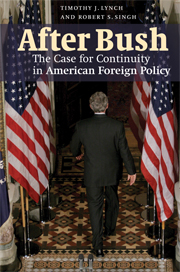Book contents
- Frontmatter
- Contents
- List of figures
- Acknowledgements
- Introduction: Winning the Second Cold War
- Chapter 1 Bush and the American foreign policy tradition
- Chapter 2 The constitution of American national security
- Chapter 3 The Second Cold War on Islamist terror: negative audits
- Chapter 4 The Second Cold War on Islamist terror: a positive audit
- Chapter 5 Iraq: Vietnam in the sand?
- Chapter 6 The Middle East: reformation or Armageddon
- Chapter 7 Frineds and foes after Bush
- Chapter 8 The emerging consensus at home and aborad
- Conclusion: The case for contiuity
- Notes
- Bibliography
- Index
Introduction: Winning the Second Cold War
Published online by Cambridge University Press: 22 September 2009
- Frontmatter
- Contents
- List of figures
- Acknowledgements
- Introduction: Winning the Second Cold War
- Chapter 1 Bush and the American foreign policy tradition
- Chapter 2 The constitution of American national security
- Chapter 3 The Second Cold War on Islamist terror: negative audits
- Chapter 4 The Second Cold War on Islamist terror: a positive audit
- Chapter 5 Iraq: Vietnam in the sand?
- Chapter 6 The Middle East: reformation or Armageddon
- Chapter 7 Frineds and foes after Bush
- Chapter 8 The emerging consensus at home and aborad
- Conclusion: The case for contiuity
- Notes
- Bibliography
- Index
Summary
My fellow Americans, I speak to you tonight with the heaviest of hearts. One hour ago, at 8.30 p.m. East Coast time, pursuant to my constitutional authority as Commander-in-Chief and in accordance with the laws of war, I authorized strikes by the United States military on the principal cities of the state of Iran, including the capital, Tehran. These attacks were nuclear in nature. They achieved their objectives in full. You will recall that, three years ago at my inauguration, I stated clearly and unequivocally that it would be the policy of the United States to regard any attack on its territory with weapons of mass destruction as an act of war and that my administration would not hesitate to hold those responsible to full, direct and draconian account. I made clear then, as I make clear again now, that whether attacks on the United States be committed by an outlaw state or by a terrorist group to whom the weapons had been supplied or sold by such a state, I would hold all relevant parties accountable. As you know, these past four weeks have seen the agencies of the federal government seek to deal with the emergency response to the vicious and unprovoked attacks in Washington, Los Angeles, and New York. […]
- Type
- Chapter
- Information
- After BushThe Case for Continuity in American Foreign Policy, pp. 1 - 16Publisher: Cambridge University PressPrint publication year: 2008



